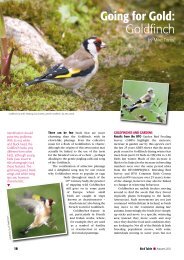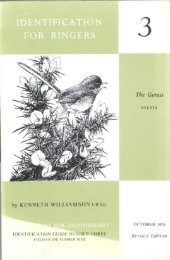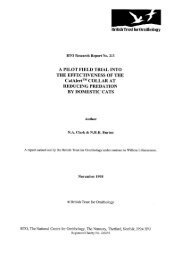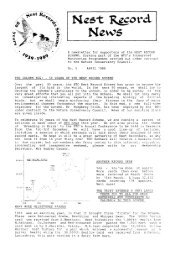Warbler - British Trust for Ornithology
Warbler - British Trust for Ornithology
Warbler - British Trust for Ornithology
Create successful ePaper yourself
Turn your PDF publications into a flip-book with our unique Google optimized e-Paper software.
ACROCEPHALUS ARUNDINACEUS 45<br />
in gardens on passage. Call-notes a harsh chak and deep churring<br />
croak. Song of REED-WARBLER type but louder, and with<br />
characteristic guttural, croaking karra-karra-karra-keek, gurk-gurkgurk<br />
etc., interspersed with shriller piping notes. Sometimes<br />
strongly mimetic, and uttered by night as well as by day, occasionally<br />
from high exposedperch.<br />
See photographs and notes by G. R. Mount<strong>for</strong>t, Brit. Birds, 44:<br />
195-7, plates 25-9. Also field-notes in the same journal by I.<br />
Houston and W. Robinson, 44: 202-4, and R. A. W. Reynolds,<br />
45: 220-1. See plate VI.<br />
Ageing. Adults have under parts sullied white in autumn, Istwinter<br />
suffused with orange-bufE In adults, tips to olive-brown<br />
scapulars, mantle and especially rump feathers are bleached and<br />
grey, giving a blotchy effect, whereas young are bright rusty-bufE<br />
1st-winter have whitish tips to flight-feathers (abraded in adults)<br />
and a rusty-buff suffusion on tertials and secondaries.<br />
Colours ofsoft parts. Bill: upper mandible dark brown, lower<br />
pinkish-flesh with dark brown tip. Legs: pale brownish-grey.<br />
Mouth: orange-red. Iris: yellowish-sepia. (The Handbook, ii, 44).<br />
Measurements. Wing, dd' 90-101, Sj2







